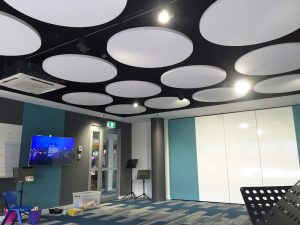
Acoustics and acoustic treatments for education environments will vary depending on the space and the intended uses for the space. ‘Good acoustics’ are equally important as ‘good lighting’ for any interior space . . . without appropriate lighting a space could potentially be “not fit for purpose” and acoustics are no different!
The same principal applies to acoustics. You may have a great space that is useful for many and varied educational activities; however, if the noise problem is too great in that space and affects the intended function of the space, it is potentially not fit for purpose!
Classroom acoustics
 Good communication should be a goal for any classroom or learning space. Acoustic planning is extremely important in classrooms to combat excessive noise that is disruptive to the learning process, affecting speech perception, student behaviour, and educational outcomes.
Good communication should be a goal for any classroom or learning space. Acoustic planning is extremely important in classrooms to combat excessive noise that is disruptive to the learning process, affecting speech perception, student behaviour, and educational outcomes.
Good acoustical design is important to enhance speech clarity and limit background noise to protect speech quality for both students and teachers.
The impact of poor acoustics affects not only the students learning, but also teachers, who use their voices most of the time in education environments, putting them at risk of vocal strain in an attempt to be heard.
Low frequency sounds and background noise should be reduced to provide better speech intelligibility and improve the communication.
Library acoustics

Having high quality, flexible acoustics in libraries is absolutely paramount to effectively accommodate for almost silence in some zones, high traffic zones and communication and discussions in other zones.
Acoustic comfort allowing library users to concentrate without any hindrances is an important factor, so reverberation and disruptive noise need to be kept to a minimum.
Library staff members need to be able to communicate with each other and library users, which means noise levels in these areas will be raised due to footfall, activities and or discussions which can be very disturbing and unsettling for many users requiring quiet.
Acoustic treatments need to be adequately designed, planned and placed correctly according to the use of the library zones.
Lecture theatre acoustics

Lecture theatres face many acoustic issues that need to be addressed in order to utilise the space effectively.
The lecturer’s voice needs to be loud and clear without any obstruction by echo and because many lecture halls are quite large causing the sound waves to scatter across the room, speech fluency may be reduced, thus affecting the learning or listening ability of the attendees.
Disruptive noise from surrounding sources can create distraction to the lecturer speaking and also to the listeners, therefore, it is extremely important that acoustic treatments are adequately considered and positioned to treat the source of potential noise, this includes internal or external sources of noise.
Employing suitable acoustic treatments to address the appropriate noise sources is all part of the planning and designing phase to ensure a good acoustic outcome.
Sports hall acoustics
Sports halls are typically large open spaces with high ceilings, hard, durable and reflective surfaces. Most ball game team sports are linked with very high noise levels, combine this with the hard, reflective surfaces and the results can be a very noisy echo chamber with reverberation times reaching well over 8-9 seconds.
Sports teachers and coaches need to communicate clearly to the team, however, with these high noise levels, they will struggle to communicate without raising their voices, making them more prone to voice strain issues as a result.
Sports halls are often used for exams and assemblies as well as sports activities making the acoustic requirements more complex, with a high degree of sound absorption treatment being crucial to address the noise problems in such open and large environments.
Materials used for acoustic solutions for sports halls needs to be carefully considered as they need to provide superior sound absorption, while also being durable and impact resistant, to withstand potential damage during ball sport activities.








It is worth noting that the role of libraries are changing. They typically house a range of activities, with quiet reading and reflection areas, group / collaborative spaces for students, teaching spaces for whole classes and as a social area during breaks. The design of such spaces needs to reflect these demands, including for acoustics, so that they can function as intended.